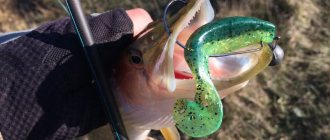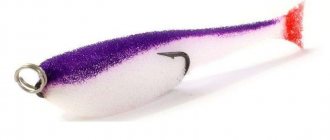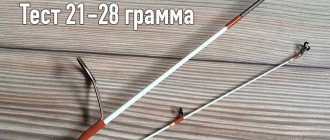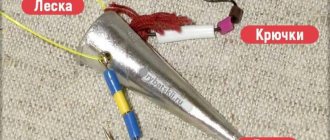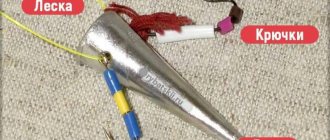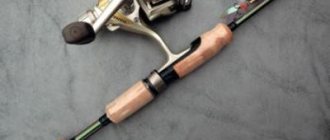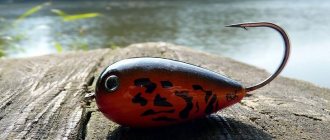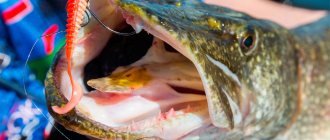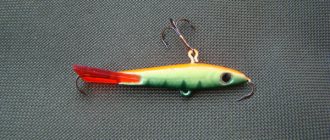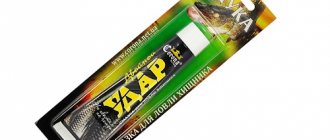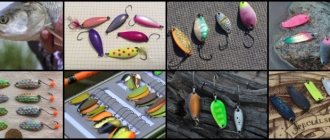A miracle of fishing thought - a foam fish
The foam fish used as bait is an exclusively domestic invention, the authorship of which belongs to Sergei Pavlov. Perhaps, if in the distant 70s of the last century, and it was then that this miracle bait appeared, there was no so-called “Iron Curtain”, and domestic fishing enthusiasts could enjoy the fruits of Western civilization without any obstacles, then humanity would be left without this very effective invention. You can find out more by reading the article about foam rubber baits.
Today, there are two main concepts of foam rubber bait, the adherents of which sometimes enter into heated debates with each other, trying to prove that their direction is the most catchy! We will not enter into a heated debate around this issue, but simply consider the two main types of foam rubber baits.
We also recommend reading:
Budget spinning reels Riobi Exiya Model range of Salmo wobblers and the Salmo Hornet catalog Features of fishing with a retractable leash, selection of gear and installation Aiko spinning rods (Aiko): catalog, features
Additional equipment for fish
You can often find unequipped foam rubber fish on sale. This is a formed piece of colored material that does not have hooks. They must be selected and installed separately. Hooks are placed on pre-prepared baits. Often fishermen use doubles or trebles. Using a sharp blade, you need to cut the body of the finished fish lengthwise and carefully place the desired hook into the cut, with its shank facing forward and the sting pointing upward. The bait ring is pulled out through the fish’s head. The place where the cut was made is carefully sealed with Moment glue: it will not get wet from moisture and will reliably hold the two parts of the foam together.
Limerick hook with ring color BN (10pcs) Helios 28 for 1 pack. Jig hook (HS-JG-29-3/0) Helios 19 for 1 pc. Double hook No. 2/0 (21520-2/0BN) Condor 19 for 1 pc. Triple hook (HS-ST-36-12) Helios 27 for 1 pc. Offset hook (HS-B-93-8/0) Helios 280 for 1 pack. Hooks AJI (AJ-BLN-14) METSUI 44 for 1 pack. Offset hook (HS-B-91-04) Helios 99 for 1 pack. Offset hook (HS-B-94-1/0) Helios 121 for 1 pack. Pin hook with ring color BN (10 pcs) Helios 42 for 1 pack. Hooks FISH GAME No. 10 METSUI 70 for 1 pack. Jig hook (HS-JG-02-4/0) Helios 22 for 1 pc. Hook Tanago KH-10003-04 Saikyo 57 for 1 pack. Hook Worm19 #10 DECOY 300 per 1 pack. Hook Worm25 #3/0 DECOY 290 for 1 pack. Jig hook (HS-JG-02-5/0) Helios 22 for 1 pc. Triple hook (HS-ST-36-5) Helios 24 for 1 pc. Hooks 115 VIKING 02NSB Cobra 63 for 1 pack. Double hook (HS-TW-01-5/0) Helios 48 for 1 pc. Double hook Double Hook Long BC No. 1/0 8 for 1 pc. Hooks WIDE RANGE WORM (WRW-BLN-2/0) METSUI 90 for 1 pack. Hooks FISH GAME No. 8 METSUI 75 for 1 pack. Aberdeen hook with ring color BN (10pcs) Helios 35 for 1 pack. Metsui CHINU hooks color bln, size No. 6 (CH-BLN-06) METSUI 55 for 1 pack. Offset hook (HS-B-93-6/0) Helios 240 for 1 pack. Offset hook (HS-B-93-3/0) Helios 165 for 1 pack. Metsui ROUND hooks color red, size No. 10 (RO-RED-10) METSUI 60 for 1 pack. Hook Normal Double Hook KH-11041-2/0 Saikyo 23 for 1 pc. Jig hook (HS-JG-29-4/0) Helios 21 for 1 pc. Hooks FlyFisher 1000 #8 (20 pcs) BZ FF 1000-08-BZ-20 127 for 1 pack. Double hooks Double Hook art. KH11040-3/0/1 Rubicon 605 for 1 pack. Hooks FlyFisher 4901 #8 (20 pcs) BZ FF 4901-08-BZ-20 144 for 1 pack. Offset hook (HS-B-93-5/0) Helios 200 for 1 pack. Double bait hook, multi-level, solderless No. 1/0 FISH SEASONS 110 for 1 pack. Jig hook (HS-JG-29-1/0) Helios 13 for 1 pc. Hooks FlyFisher 1000 #12 (20 pcs) BZ FF 1000-12-BZ-20 127 for 1 pack. Hooks FISH GAME No. 4 METSUI 81 for 1 pack. Triple hooks Round Treble art. KH11030-10/1 Rubicon 430 for 1 pack. Triple hook 13-10-10-386 /ST-36BC-18 OWNER 360 for 1 pack. Hooks FlyFisher 4901 #14 (20 pcs) BZ FF 4901-14-BZ-20 144 for 1 pack. Jig hook JG-29 No. 2/0 color BC (HS-JG-29-2/0) Helios 15 for 1 pc. Tee No. 8 15 for 1 piece. Tee ST36BN-№6 FORMIX 20 for 1 pc. Hooks FlyFisher 4901 #6 (20 pcs) BZ FF 4901-06-BZ-20 144 for 1 pack. Single hook 13-10-10-161 /50922-04 OWNER 105 for 1 pack. Hook WRM951 #1/0 Hayabusa 180 for 1 pc. Offset hook No. 10 color BN (5 pcs) Helios (HS-1205-10) Helios 103 for 1 pack. Double hook (HS-SD-36-1) Helios 38 for 1 pc. Offset hook (HS-B-93-7/0) Helios 275 for 1 pack. Metsui hooks LONG PLAINSHANK color bln, size No. 10 (LP-BLN-10) METSUI 55 for 1 pack. Tee ST36BN-No. 5 FORMIX 20 for 1 pc. Baitholder hook with ring color BN (10 pcs) Helios 32 for 1 pack. Offset hook No. 4/0 color BN (5 pcs) Helios (HS-1205-4/0) Helios 132 for 1 pack. Double hook (HS-SD-36-3/0) Helios 46 for 1 pc. Triple hook (HS-ST-36-20) Helios 51 for 1 pc. Double V-Double (BN) No. 6 Kosadaka 12 for 1 pc. Hooks COLMIC NUCLEAR B.2000 n.18 220 for 1 pack. Hook A1 Team Feeder Fine Feeder No. 14 Gamakatsu 195 for 1 pack. Tee No. 1 15 for 1 piece. Single hook OWNER 53118-08 (7 pcs) OWNER 150 for 1 pack. Double hook (HS-SD-36-6) Helios 32 for 1 pc. Offset hook (HS-B-93-4/0) Helios 190 for 1 pack. Doubles Cannelle (2205 N) No. 5 pack nickel, 90 degree rotation (305-020)_ 1,000 for 1 pack. Hook Maru kaizu (HS-MK-16) Helios 126 for 1 pack. Offset hook No. 3/0 color BN (5 pcs) Helios (HS-1205-3/0) Helios 121 for 1 pack. Single hook OWNER 53101-10 OWNER 105 for 1 pack. Double bait hook, multi-level, solderless No. 3/0 FISH SEASONS 100 per 1 pack. Tee hooks (2082-001) Cobra 1,200 per pack. Double hook (HS-SD-36-4) Helios 36 for 1 pc. Hook Wide Gape X-10 Korda 540 for 1 pack. Double hooks Cobra gray. 2080 size 001/0 (50pcs) (2080-K010) (pieces) Cobra 25 for 1 pc. Tee ST36BN-№2 FORMIX 25 for 1 pc. Triple hook 974 No. 12 EAGLE CLAW 14 for 1 pc. Double hook (HS-SD-36-2/0) Helios 41 for 1 pc. Tee No. 2 15 for 1 piece. Tee hooks (2082-008) Cobra 910 for 1 pack. Tee hooks (2081-012) Cobra 1,100 per pack. Tee 3981BN Kosadaka No. 12 Kosadaka 14 for 1 pc. Hook Saikyo Crystal KH-11004RBN-012 (10pcs)_ Saikyo 57 for 1 pack. Offset hook No. 5/0 color BN (5 pcs) Helios (HS-1205-5/0) Helios 132 for 1 pack. Triple hooks Round Treble art. KH11030-2/0/1 Rubicon 680 for 1 pack. Triple hook Treble Hooks No. 10 AIKO 30 for 1 pc. Double hook TIN TW-01-01 OWNER 335 for 1 pack. Offset hook No. 12 color BN (5 pcs) Helios (HS-1205-12) Helios 103 for 1 pack. Triple hook (HS-ST-36-1) Helios 27 for 1 pc. Hooks AJI (AJ-BLN-09) METSUI 50 per 1 pack. Offset hook (HS-B-93-10/0) Helios 300 for 1 pack. Double hook TW-01BC-02 OWNER 375 for 1 pack. Hooks COLMIC NUCLEAR B.2000 n.20 220 for 1 pack. Triple hook 974 No. 1 EAGLE CLAW 14 for 1 pc. Hooks WIDE RANGE WORM (WRW-BLN-06) METSUI 55 for 1 pack. Tee hooks (2081-010) Cobra 1,100 per pack. Double hook No. 4/0, black nickel color (50 pcs/pack) Condor (21520-4/0BN) Condor 25 for 1 pc. Iseama hook with ring (HS-IS-5) Helios 72 for 1 pack. Hook Maru kaizu (HS-MK-18) Helios 135 for 1 pack. Double hook (HS-SD-36-1/0) Helios 40 for 1 pc. Hook Mustad 94833 BLN No. 20 94833 BLN No. 20 Mustad 2 for 1 pc. Triple hook (HS-ST-36-4) Helios 24 for 1 pc. Triple hooks Round Treble art. KH11030-12/1 Rubicon 370 for 1 pack. Offset hook No. 1/0 color BN (5 pcs) Helios (HS-1205-1/0) Helios 121 for 1 pack. Hook H.LBT571 #7/0 black nickel Hayabusa 180 for 1 pc.
If several hooks are used at once, then they must be placed one after another and firmly connected to each other with piano wire (it is quite strong and reliable). To avoid making a cut for the hook, the foam rubber can be burned with a pre-hot awl. The porous material will easily yield to this manipulation and the equipment can be securely fastened.
Cargo Collapsible bullet 24g Tonar 17 for 1 piece. Cargo Collapsible bullet 32g Tonar 20 per 1 piece. Load Cheburashka DO IT 24g unfolded ear Tonar 16 for 1 piece. Cheburashka weight with fastener 18g Tonar 18 for 1 piece. Cargo Collapsible bullet 40g Tonar 22 for 1 piece. Load Cheburashka collapsible 56g Tonar 34 for 1 piece. Load Cheburashka collapsible 52g Tonar 32 for 1 piece. Cargo Collapsible bullet 36g Tonar 22 for 1 piece. Load Cheburashka ear Do-it 36 g Tonar 26 for 1 piece. Cargo Collapsible bullet 20g Tonar 15 per 1 piece. Cargo Cheburashka ear Do-it 32 g Tonar 27 for 1 piece. Cargo Cheburashka ear Do-it 44 g Tonar 28 for 1 piece. Load Cheburashka collapsible 48g Tonar 31 for 1 piece. Drop weight (2 rings) for snags bullet 42 g Tonar 34 for 1 pc. Load Cheburashka ear Do-it 28 g Tonar 27 for 1 pc.
A foam fish must have a weight. The best option is considered to be a “Cheburashka” attached to a foam fish after three winding rings. The game of such bait becomes more realistic. The winding rings are easy to install using fishing pliers. However, today fishermen are increasingly using more modern collapsible weights, which also allow them to achieve good results. Their use allows you to quickly change bait. There are no special requirements for the shape, but it is desirable that it be streamlined.
Types of foam rubber baits
- Fish. Based on the name, it is quite clear that this foam rubber bait is most similar in shape to a fish. It also contains fins and, importantly, a tail! The coloring of the bait is appropriate, and as for the game, the foam fish has its own game, even on a uniform retrieve! The area of application is usually in stagnant water, that is, where there is no or weak current. In this case, the conditions are the same as when using silicone jig baits.
- Carrot. Such an exotic name for the bait is due to its shape. Since this bait lacks a tail and fins, it really resembles a vegetable or a cigar - each has its own associations! This bait has simply excellent compactness, which naturally allows you to make long casts. Well, the action of the bait is given directly by the current, hence the scope of its application, and, of course, different types of wiring - stepped, wave, and so on.
DIY foam fish
When making a foam fish with your own hands, you should not give the body size more than 15 cm, because wet foam stretches in the air and because of this, the casting range is reduced.
Often predatory fish bite off the tails. To prevent this from happening, you need to “implant” a simple hook into the ponytail.
The survivability of a foam rubber fish can be improved for the better by a braided fishing line passed through the entire body and ending at the exit with an attractive small tail.
Advantages of foam rubber baits
Why is foam rubber so attractive, and why has it become so popular among domestic fishermen?
This becomes obvious after an objective assessment of the advantages of this bait, which are as follows:
- Softness of the material. That is, when a fish grabs a foam bait, it causes absolutely no fear, since it is mistaken for a real living object. In addition, the hooks, for the same reason, instantly become exposed!
- Directly in the water, the bait takes a vertical position or close to it, which reminds a predator of a tempting fish that feeds at the bottom.
- Foam rubber soaked in water acquires maximum elasticity, which directly affects its game, which becomes simply amazing and very attractive to a predator!
- Foam rubber bait, especially the “carrot” bait, is very long-range. It can only compete with a monolithic vibrator of the “Kastmaster” type.
- The quality of the foam rubber from which the baits are made allows you to make almost perfect non-snags! The fact is that the elasticity of the material allows, even in the event of a collision with some underwater obstacle, to return the shape of the bait to its original position. Silicone, for example, after being hooked cannot take its original shape on its own, so the hook becomes bare.
- Since foam rubber itself is porous, it is very convenient to impregnate it with all kinds of flavors and attractants, the effect of which will be quite long.
- And finally – the price. I bought a set of sponges for the ridiculous price of half a dollar and cut fifty baits - beautiful!
The longer the better (2 hours)
14.06.2012 End, (beginning)
LURE AND THEIR EQUIPMENT
In general, all the same baits are suitable for fishing with a retractable leash as for a classic jig. You can, in particular, fish with foam rubber fish, but there are certain difficulties. Foam rubber baits are very light. They are very light in weight for their volume, and to use them on a retractable leash, additional loading is required. It can be hooks made of thicker wire, a lead strip wound onto the shank of the hook, there may be other options, but this is a rather painstaking task. Based on my experience, I can say that in this case the game is not worth the candle.
On a retractable leash, you can also use rotating spoons, usually small, with minimal loading, but this is a topic for a separate discussion.
As for silicone baits, as I have seen more than once on different bodies of water, preference should be given to twisters. Problems often arise with vibrating tails. Due to their body shape, they are very prone to leash twisting. You can combat this by placing a small but high-quality swivel directly in front of the bait, but this does not always save the matter. Another way is to install a load on the fore-end when equipping the bait with an offset hook. This option is simpler and cheaper, but it also does not work with all vibrating tails.
In most cases, with a retractable leader, smaller baits are used than in a classic jig. As a rule, everything is limited to three inches (7.5 cm). Larger rubber tends to tangle behind the main line when casting and significantly reduces its casting range.
It’s worth remembering here that there is an opinion among spinning anglers that a smaller predator is always caught on a retractable leash than on a classic jig. We can partly agree with this, although I had to catch pike weighing 3–3.5 kg and pike perch weighing 2.5 kg with this rig, which can hardly be called small. Nevertheless, such a pattern can be generally traced, but it is difficult to say what is the matter. Perhaps the main reason is that the bait on a retractable leash still goes higher, further from the bottom, than a regular jig. This can serve as an explanation if we accept that the smaller the fish, the easier it is to lift. Maybe it's all about the slower movement of the bait. And its relatively small size is also, apparently, not the last factor.
However, the main problem with a retractable leash - as with other methods of fishing from the bottom or near the bottom - is the hooks. The easiest way to deal with them is to use offset hooks and install the bait according to the non-hooking principle. In addition, unlike a regular hook, the offset hook, since the fore-end passes under the bait, prevents it from turning over with the tip down. However, spinners have a very ambiguous attitude towards offsets and non-hooking ones. Many are convinced that the less the bait catches snags, the less it catches the fish. I won’t argue, but I will note that good hooks almost completely solve this problem. The only situation in which even the best offset fisherman turns out to be powerless occurs when the pike perch is not enough, but presses the bait to the bottom.
And yet, if the bottom allows, it is better to use baits equipped with doubles: the effectiveness of hooking immediately increases very noticeably. However, with doubles, the same problem arises as with ordinary singles: if the fore-end passes through the body of the bait more or less in the middle, then when retrieving it will constantly turn over with its tips down. This position of the bait does not affect the quality of the hook (except for the “clamps” of the pike perch, when hooking is impossible), but in this case the hooks cling to snags more often and a lot more garbage is collected. To avoid all this, you need to equip the bait in such a way that its center of gravity is shifted downward.
WIRING
Again, when compared with a classic jig rig, a retractable leader provides the spinner with more options for different retrieve options - from slow, even retrieves to aggressive twitch, similar to what is used when fishing with poppers. However, the need for these extremes rarely arises. Personally, I most often use stepped wiring: two gentle turns of the coil - and a pause. However, there are differences from the classic jig step. There, reeling begins immediately after the bait falls to the bottom. With a retractable leash, after the sinker has fallen to the bottom, you need to pause so that the bait also sinks to the bottom. This pause can vary and, depending on the strength of the current, the thickness and length of the leash, the geometry and weight of the bait, can range from 2 to 10 seconds. The duration of the pause will also depend on the length of the cargo leash: the shorter it is, the shorter the pause, since the bait is lowered from a lower height.
Uniform wiring in its pure form with a retractable leader is not used, but it gives very good results in combination with twitching with the tip of the rod. The spinner uses the tip of the spinning rod to make a short jerk, single or several, without stopping the slow reeling of the reel. The frequency and amplitude of jerks can be different and largely depend on the fishing conditions and the activity of the predator. So, in the Lower Volga this spring, before the ban, there were no bites at all on even retrieves, and even with single jerks. The following option worked best: one short jerk, a pause, two quick ones, then a pause for 10 seconds so that the bait dropped to the bottom. Bites most often occurred either when the bait was falling or at the very beginning of the retrieve after a pause.
Recently, some spinning anglers have begun to use wiring consisting of sharp short jerks, similar to hooking. From the outside, you might think that the person is trying to make the fish look purple, but this is not so. With a retractable leash, cases of purple spots are extremely rare. Sharp short jerks have an effect for another reason: they activate the game of the bait, make it move in short nervous jerks, as if it were a wounded fish.
DIVERT VERSUS CLASSICS
There is, of course, a lot in common between a classic jig and a retractable leash, but there are situations when one of these methods has a clear preference. Thus, a diverting leash is most effective when fishing in weak and medium currents. Under these conditions, the play of the bait on a long leash is very natural and closely resembles the movement of an exhausted or wounded fish.
More than a classic, a retractable leash is also suitable for catching steep edges. An ordinary jig bait, having reached the edge, simply rests against it. The same thing happens with the load on the outlet leash. It also rests on the edge, but the bait on a long leash continues to play and ends up in the most promising zone, directly behind the edge ridge. To get the maximum effect, it’s worth giving a pause of a few seconds after the load has hit the bottom so that the bait drops over the edge. In a relatively strong current, the pause can be extended to ten seconds or more. The jet does not allow the bait to sink and forces it to play directly behind the edge, where the predator most often lies in ambush.
There are other situations where a lead rig is preferable to a jig. For example, it is very effective when catching perch near the coastal reeds, when the fish is directly in the grass. The cast is made along the edge of the thicket, and when the bait lies on the bottom, 4-5 quick turns of the reel are made, followed by a long pause, during which the bait sinks very slowly. A bait that plays slowly while falling usually lures large perch out of the grass.
A retractable leash is also good for catching fish in deep water. In the Lower Volga I was very successful in catching sabrefish this way. After casting, I let the load drop about two meters and then started retrieving with small jerks with the tip of the rod. The bait moved in jerky movements, which apparently attracted the saberfish. It is simply impossible to achieve such a game with classic jig equipment, even ultralight. The movements of the bait, combined even with a light load, become convulsive and rarely cause a bite.
It may seem that there are so many advantages to using a lead jig that it is time to retire the classic jig. Someone might agree with this, but I think it would be unjustified. The jig allows you to work with large baits, which usually appeal to the largest predators, and here the retractable leash is not a competitor.
| Author | Nikolay Lazutenkov, Moscow |
| Read the article | 7810 |
Rating: 3.35
Types of wiring of foam rubber baits
Now, it’s worth talking about the different types of wiring for a foam rubber bait. There are quite a lot of them, and they are as follows.
Step wiring is perhaps the most common method, which, moreover, is a classic one. With this wiring, the foam rubber wriggles attractively, especially in the current. And if it is also a fish, then it wiggles its tail seductively for a predator, just like a vibrating tail.
Wave wiring is also a very effective method. It is used for foam fish, which are usually led closer to the bottom of the reservoir, and at the same time, they make light vertical swings with the rod. Thus, the bait moves over a wide amplitude and wriggles very energetically and appetizingly for a predator.
About baits
The diverter is a classic of spaced jig equipment, and then the main jig baits are vibrotails, worms, slugs, crayfish, twisters, foam rubber.
But this does not negate the fact that Moscow can be successfully caught with wobblers, dead fish, and in some cases you can successfully catch with wide, slowly falling spoons.
Williams Wabler - can be successfully used on a branch
When choosing jigs and other types of baits, it is worth considering that the classic wiring of a retractable leash on a pike involves the slowest and laziest animation. Therefore, it is important that the silicone or other bait performs well on a slow retrieve. This is perhaps the main point that should be taken into account in this aspect of fishing for Moscow.
The rest is a choice of color, size, shape, as in other jig fishing methods. Read more about how to choose bait for pike here.
Secrets of fishing with foam bait from experienced fishermen
Often, in a particular body of water, situations arise when it is quite difficult to fish one or another promising area, for example, a pit, a small space between snags, an underwater island, and the like. We also recommend that you read the material about silicone baits.
In this case, the foam rubber allows you to examine such a place as closely as possible.
- To do this, it is necessary to guide the bait with a step, thus probing the bottom of the reservoir.
- After the treasured place has been found, the bait must be stopped, and with the tip of the rod continue to lightly play along, literally, with one so-called poke, shift the weight-head along the bottom by just a few centimeters.
- Well, if there is a current in this place, that’s generally great, as it will give the bait additional play!
Equipping foam fish with hooks
Most “foam rubber” are equipped with one hook (double or triple), located at the bottom in the middle of the bait (Fig. 54).
Fig.54. Equipment options for foam rubber fish; a) a double on the load; b) tee with a winding ring; c) equipment with an extension wire.
If the hook has a long enough shank, then its eye can be removed from the “fish” in front and a load can be attached to it. The tee is connected through the winding ring (here the eye should be positioned vertically), the double hook is first put on the weight, and then the “fish” is “glued” onto the double. It’s even better if the sinker has one loop made in the form of a fastener. But usually in the equipment you have to use an extension wire (Fig. 54c). It may even be copper, but it is strong enough. The wire is twisted behind the double (tee), crimped so that the hook does not dangle, and the foam is pierced, bringing the free end into the nose of the “fish”, then a vertical loop is twisted, through which the bait is attached to the sinker through a winding ring. To simplify the procedure, first, using a heated rod, we burn a channel to the length of the hook shank, then the foam rubber is pierced only with a wire, i.e. The “fish” “rests” on the double’s ear and does not slide down. Another option is possible, when all the equipment is glued into a cut on the body of the bait.
For rare and cautious bites, it is better to make an elongated fish and equip it with two doubles (Fig. 55).
Fig.55. Equipment options for foam rubber fish; a) a double on the load; b) tee with a winding ring; c) equipment with an extension wire.
Non-meshing options are widely used (Fig. 56). Since the foam is very soft, it is easily compressed when grasped and allows the hooks to hook the fish.
Fig.56. Non-snacking rigs for foam fish: a) hidden single hook; b) pressed double; c) hidden tee.
Alas, the usual foam equipment system is imperfect. Once the hook is glued in or the front loop is twisted, it will no longer be possible to replace the fish with another. What if she was “cut” by predators?
Pavlov's trap - universal equipment for foam fish
The “trap” rig created by Sergei Pavlov is brilliant in its simplicity, versatility and efficiency (Fig. 57). It is an order of magnitude superior to the well-known Draskovic rig and other models.
Fig.57. Sergei Pavlov’s “trap” rig: a) elements of the rig; b) rig assembly; c) self-locking lock.
The idea of a “trap” is a slamming system with insurance against opening. The spring wire lock not only holds the bait on all six sides, but is also self-locking—it closes itself. All equipment elements: lock, axial rod, sinker and leash with hook are mounted on the winding ring and can be easily replaced if necessary.
This design is universal, because suitable for any bait: from foam rubber and rubber to natural fish, and all of them can withstand maximum casting.
In a “trap”, baits are changed as easily as a clip in a pistol or a cassette in a tape recorder - reliably, profitably, conveniently!
Another fundamental innovation of Pavlov’s “trap” is that it is equipped with a tee on a “tared” leash. For the leash, soft nichrome wire with a diameter of 0.25 mm, twisted in half, is used. It has high elasticity, i.e. withstands a large number of bends without breaking, and is easily twisted by hand even without tools.
The soft leash allows you to attach the tee anywhere in the bait: at the top, bottom, side or closer to the head.
By experimenting with a dynamometer, you can establish that a nichrome loop, depending on the number of turns of twist, unravels at a certain load. This allows you to “set the breakout force” yourself, then if there is a “dead” hook on a strong fishing line, only the hook is lost, everything else is preserved. We quickly screw on the new tee and continue fishing.
Photo: Pavlov’s trap rig.
Thus, Pavlov’s “trap” has undeniable advantages:
- The bait is quickly and easily replaced.
- When hooked, only the hook comes off, and a new tee can be quickly screwed onto the leash.
- The trap is suitable for any bait with a “fish” head. For the round body of twisters, you can make your own version with an appropriate grip.
The design of the stainless steel trap with a diameter of 0.6 - 0.8 mm makes it possible to adjust the system “in place” by bending or spreading the wire.
The convenience of the invention is noted by all fishermen, incl. Stanislav Radzishevsky: “When fishing with foam rubber, I use exclusively baits made by the hands of Sergei Pavlov, whose “fish” I consider to be definitely the best, especially the 9-centimeter ones with a red back. For fastening, I only use his own “traps”; by the way, they hold both vibrating tails and large twisters perfectly.”
